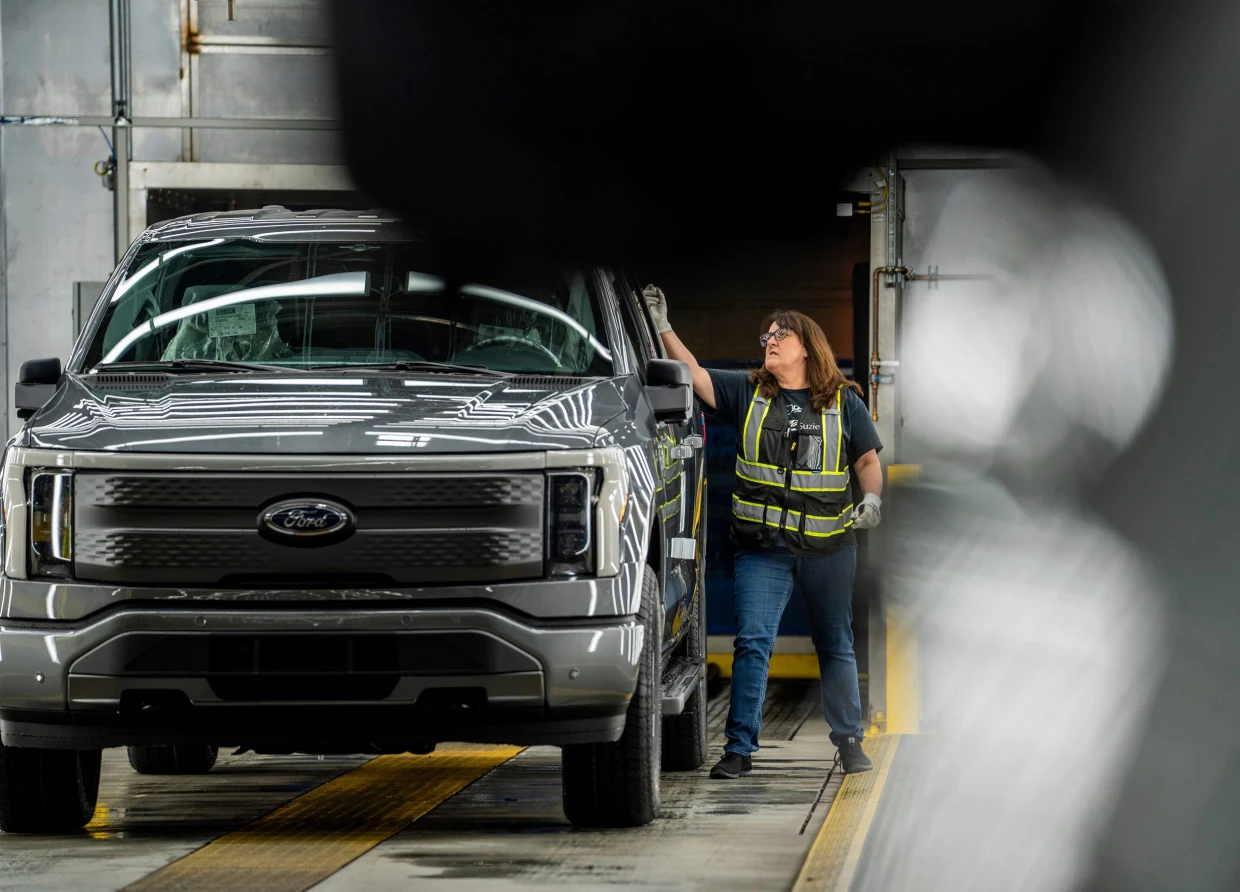This year was shaping up to be a good one for the workers at the GM Orion Assembly plant in a working-class suburb of Detroit. After winning a pay raise following last year’s United Auto Workers strike, they were slated to start production later this year on a marquee product for GM: the electric Chevy Silverado pickup truck.
But like thousands of other workers on the front lines of the electric vehicle transition, they have hit some bumps in the road. GM told the nearly 1,000 workers at the Orion plant in December that they were being laid off until late 2025 to make engineering improvements and amid cooling demand for electric vehicles. Their last paycheck was their holiday pay the week of Christmas, and many are still waiting to find out if they will be offered a job at another plant.
“It’s been a very somber moment here the last month,” said an employee at the plant who asked not to be identified because they weren’t authorized by GM to speak to the media. “We thought we finally got a little bit of a break. We were only supposed to be down for at most for a year for retooling, and now GM is revisiting the EV market. I don’t think the economy is hurting — I think the automotive industry is hurting. In my opinion, they put the carriage in front of the horse.”
While sales of electric vehicles have continued to increase, demand has slowed from the breakneck pace in 2022 and 2021, causing automakers, including industry leader Tesla, to project a slowdown in sales this year. That has U.S. automakers pulling back on some of the lofty electric vehicle ambitions they have poured billions of dollars into in recent years, leaving thousands of workers with their jobs in jeopardy.
“Ultimately it all stems from demand, and demand is just not showing up to where all these CEOs thought. So a lot of the initial targets put out by GM or Ford a couple years ago have maybe proven to be a bit too optimistic and probably too aggressive,” said Gabe Daoud, a sustainable energy senior analyst at TD Cowen. “I think everybody was expecting the entire car fleet to change overnight and go electric, but that’s obviously just impossible and impractical.”
Along with GM, Ford said in January it is cutting back on production of its electric pickup truck the F-150 Lightning amid slowing demand, eliminating 1,400 workers from the production line in Dearborn, Michigan, starting in April. Ford said the majority of those employees will be reassigned to a different role at the same complex, transferred to other plants making gas-powered vehicles, or offered early retirement.
Hundreds of workers at electric vehicle battery plants have also been laid off in recent months in Michigan, Georgia and California. North Carolina-based Albemarle, which supplies battery makers with lithium, also said in January it was cutting an unspecified number of jobs due to changing market conditions.
Ford said last fall it would delay about $12 billion in previously announced EV spending, pushing back construction on one of its two Kentucky battery plants and scaling back plans for a battery plant in Michigan that will now eventually employ 1,700 workers, down from a planned 2,500.
Demand for electric vehicles has continued to grow, with a record 317,000 EVs sold in the fourth quarter of 2023, up 40% from a year earlier, according to Cox Automotive. But the pace of that growth has slowed from 2021 and 2022, when the industry was seeing 70% and 80% year-over-year growth. Over the past three years, companies have been pouring billions into electric vehicle investments, spurred on by incentives pushed for by the Biden administration.
Analysts have attributed that slowing demand largely to the relatively high price of EVs, particularly as interest rates on auto loans have risen, and consumer concerns about a lack of charging infrastructure.
“I think what you’re seeing is the slope changing in how fast people are willing to purchase EVs right now because they’re expensive and there is concern about charging infrastructure,” said Alan Amici, CEO of the Center for Automotive Research. “If you’re an efficient automaker, you’re trying to match your production to demand. It doesn’t do anyone any good to fill up a yard with EVs that are not being sold.”
The industry faces further uncertainty with the upcoming U.S. presidential elections, where the electric vehicle incentives put in place under the Biden administration could be undone or stalled under a second Trump administration, analysts said.
The layoffs came after a win for autoworkers last fall when they secured a more than 25% pay raise and other benefits following a more than monthlong strike. The new contract also offers added benefits to protect laid-off workers, like allowing them to more easily transfer to plants making EV batteries, and includes incentives for early retirements if the automakers have to downsize their workforce, said Art Wheaton, director of labor studies at Cornell University.
“In the collective bargaining agreement they just negotiated, the UAW had first and foremost on their mind job security,” said Wheaton.
At the Orion plant, workers had been anticipating being laid off for a large part of 2024 while the plant shifted production from the Chevy Bolt to the new electric Silverado, but many were caught off guard when GM announced in December that those layoffs would be extended by an extra year, said the plant worker.
“It’s very devastating, not only to our workforce, but to the whole community there,” said the plant worker. “Things were growing, things were looking good and people were happy. We got nothing but support from the township, and all this money was coming in from the state, and then they do this.”
The plant, which has been through its ups and downs since being built in the 1980s, was the center of much hype just two years earlier. At a press conference, Michigan Gov. Gretchen Whitmer and GM officials announced the company’s plan to spend $4 billion to expand and renovate the facility to make the electric Silverado truck as part of a wider $7 billion investment in the state that GM said would support 5,000 jobs.
In exchange for the investment by GM, the state of Michigan gave the company hundreds of millions of dollars’ worth of grants, money for infrastructure and utility upgrades and state and local tax credits.
GM plans to be able to offer all of the laid-off employees jobs at other plants in Michigan, and about half have already been placed or are in the process of being placed in new positions, said GM spokesperson Kevin Kelly.
But relocating could be a strain on some workers, including those who are already traveling more than an hour to get to the Orion plant and others who might not be able to manage a longer commute with family or child care obligations, said the plant worker.
For UAW workers not reassigned to another plant, GM will provide compensation on top of their state unemployment for up to two years, which amounts to 84% of their normal pay along with their health care coverage, said Kelly.
Those benefits won’t apply to non-GM workers at the plant not covered under the UAW contract with GM, like those working in maintenance, sanitation and security jobs.
Despite the layoffs and production delays, local officials are still expecting the planned investment in the plant to be a boon for the working-class community that still holds on to its motto — “where living is a vacation” — from its days as a 19th-century tourist destination.
Orion Township Supervisor Chris Barnett said several suppliers that will make components for the EV Silverado, like the seats and bed liner, have continued planning to build new facilities nearby despite the production delays, and the project has also helped attract other businesses, like hotels and restaurants.
While Barnett said he was disappointed to hear production was being pushed back, he wasn’t surprised given the amount of construction that needed to take place in a relatively short time to meet the planned 2024 rollout of the EV Silverado. He said work on the plant has continued and he was there recently for a meeting.
“While no one’s excited that it’s sort of been delayed, I have no feeling that this project is going to be abandoned or shelved,” said Barnett. “When this news came out, we all internally were like, that makes sense. There was nobody that was like, ‘The sky is falling.’ There was no panicking.”
In Hardin County, Kentucky, officials are in a similar position. Ford was expected to open two battery plants there, one in 2025 and another in 2026 that would employ 5,000 workers. But in October, the company said it was delaying the opening of the second plant due to slowing EV demand.
Still, local officials are expecting a huge boost to the economy from just the one plant, which will create at least 2,500 jobs and transform the largely rural community about an hour from Louisville, said Hardin County Judge/Executive Keith Taul.
“It’s totally changed everything about the area with these two massive buildings,” said Taul. “I was in automotive for 30 years, I traveled around the world, and so I’ve seen some big projects. But this has got to be one of the biggest I’ve ever seen.”
Several suppliers are already relocating to the region to be closer to the plant, and developers have been looking at land for housing developments with the expectation that eventually thousands of workers will be relocating to the region, said Taul. The delay to the second plant will help give the community more time to prepare for the influx of workers the county is anticipating.
“There are going be bumps in the road for anything new like this,” said Taul. “I think most people understand that Ford and their partner, they’re not going to produce a zillion batteries that aren’t going to be sold. They have to supply the demand that is out there.”




